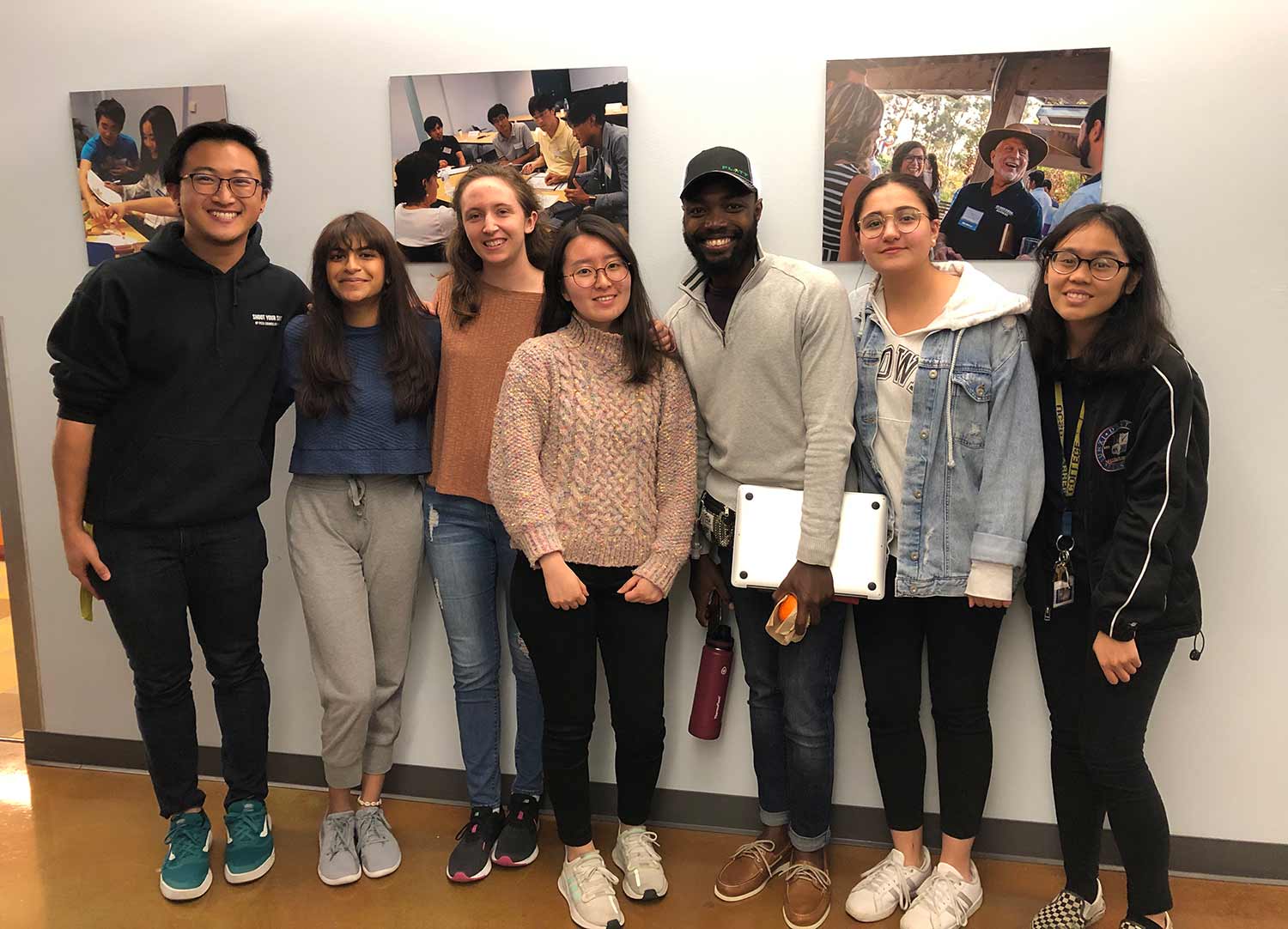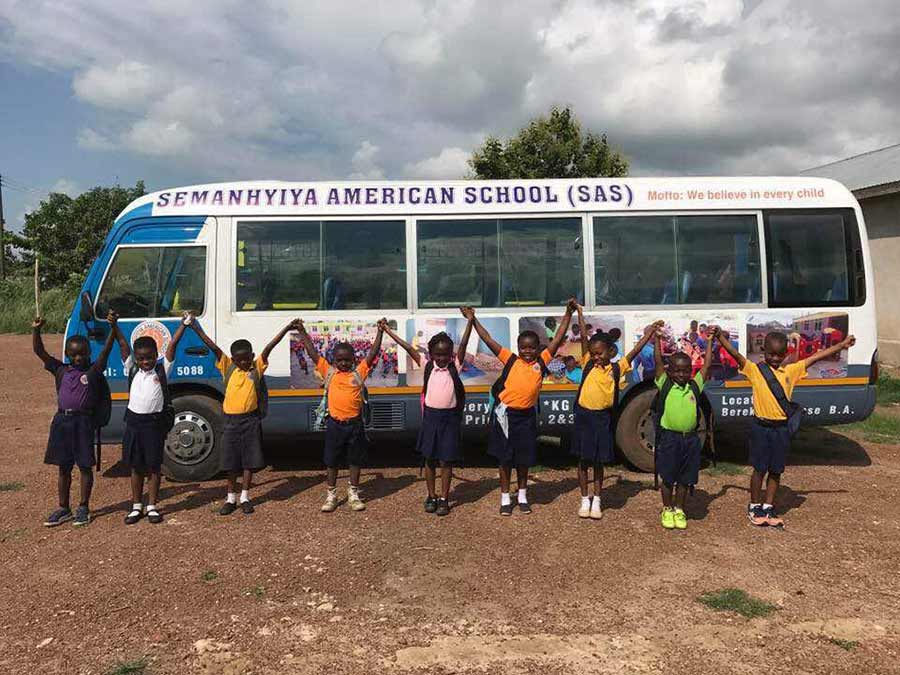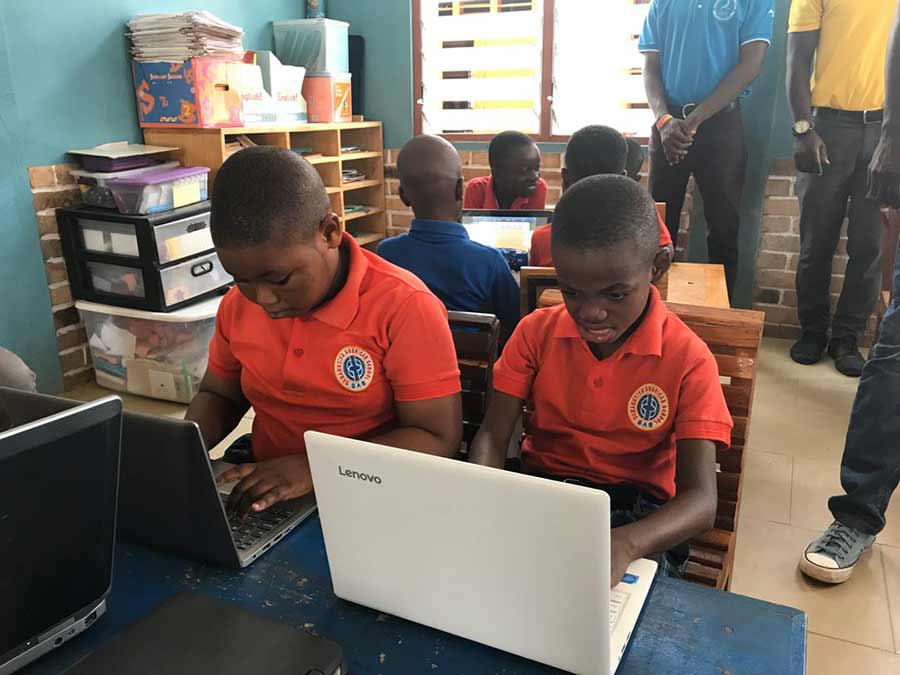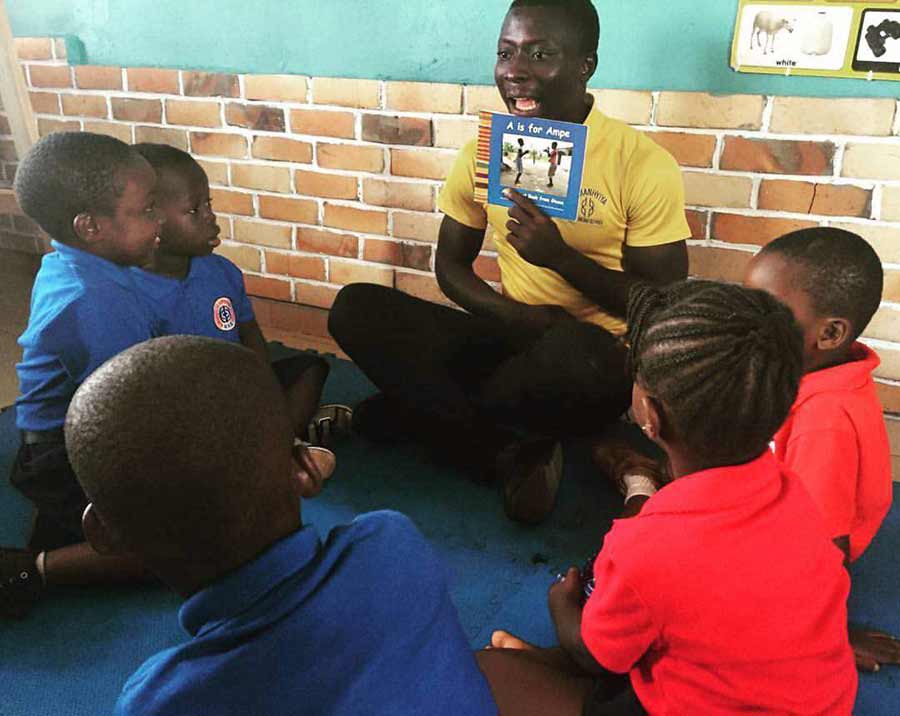
By:
- Katherine Connor
Published Date
By:
- Katherine Connor
Share This:

The Schoolhouse Ghana student team with Godfreds Foundation co-founder Fredrick Benneh Frimpong, third from right. The students, from left to right: Matthew Chen, Vanshika Agrawal, Neve Foresti, Sohyun Lee, Cristina Barney, and Cynthia Butarbutar. Photo courtesy of Global Ties.

Undergraduate Students Bring Intranet to Rural Ghanaian School
A few years ago, a photo went viral of a Ghanaian schoolteacher who drew detailed computer screens and software systems on his blackboard every morning so that his students—who didn’t have access to computers—could have a shot at passing the computer literacy portion of their exams. Now, a team of UC San Diego students has partnered with a school in Ghana that faces a similar challenge, and created a more effective and scalable solution.
The team of undergraduates, who are part of the Global Ties program at the UC San Diego Jacobs School of Engineering, developed a self-sustaining and scalable computer server and intranet system. The system will allow teachers to download Internet pages and educational materials that students can access anytime at school—even when there is no Internet.
It will be installed at the Semanhyiya American School (SAS) in the rural village of Senase, Ghana this summer. The Global Ties Schoolhouse Ghana team partnered with the nonprofit Godfreds Foundation, which runs SAS, to ensure the system met the school’s needs.

The Global Ties students partnered with the nonprofit Godfreds Foundation and its Semanhyiya American School in the rural village of Senase, Ghana, to develop an intranet server that would meet the school’s needs. Photo courtesy of SAS.
In Ghana, all students take a national test in ninth grade, which includes a section on computer literacy. Students who don’t pass this test aren’t able to progress past ninth grade.
While the rural school has one shared computer lab for all the students—who don’t have computers at home—the WiFi is spotty at best, and prohibitively expensive. This means the students often aren’t able to access the materials their teachers would have liked, and struggle to complete their computer curriculum.
“The goal is to provide these students with access to the technology that we have access to thanks to the internet,” said Cristina Barney, a bioengineering student and the Schoolhouse Ghana undergraduate advisor. “We can’t change the reliability or cost of the internet in Ghana or in that school location. We can’t do much about that, so we saw an opportunity to change the perspective and maybe instead of trying to have better internet, have a system that can work around the problem.”
Compounding the lack of internet is the reality that textbooks are very expensive, so each student isn’t able to have a copy of the books used. Having reliable access to the internet will allow teachers to add more resources from digital versions of textbooks, as well as from different media including videos and interactive websites, to their toolbox.
The Schoolhouse Ghana team got a boost recently when the project was accepted into the Clinton Global Initiative-University (CGIU), the higher education program of the Clinton Foundation. Through CGIU, the project will receive mentorship from leaders with experience completing similar social innovation projects, and a completion plan template with timetables to finish small portions of the project, to ensure the entire system is complete and ready for installation by the summer.

Students in the school’s one computer lab, where access to internet is spotty and prohibitively expensive. Photo courtesy of SAS.
Barney and Neve Foresti, a cognitive science student with minors in sociology and visual arts speculative design and the current Schoolhouse Ghana project team lead, were accepted to participate in the CGIU conference in Edinburgh, Scotland in April. They’ll have an opportunity to meet student teams from around the world tackling other social innovation challenges, and participate in leadership development, mentorship, skills training, and partnership building workshops.
The system the UC San Diego students developed includes a rugged computer server, an intranet, web crawler, and a network-attached storage platform. All told, it will allow teachers to download and store the webpages they want when there is WiFi; the students will then be able to access them regardless of internet availability. Students can also practice emailing one another; use internet-based software programs; and access the vast depths of knowledge available online, even when there is no WiFi.
“We want to have a working server that has at least four main components: email, data storage, a working interface webpage for students, and a working web crawler—the crawler is what downloads all the pages into the actual interface,” said Barney. “But thinking ahead about a more long-term solution, we want to be able to create a standardized manual to recreate this for other schools that need it.”
Another key component of the project is its relevance for SAS teachers, said Foresti.
“A really big part of this system is that it’s being worked into the curriculum,” Foresti said. “We have the curriculum of the school, and we’re building this system and the website with that curriculum in mind in terms of the computer literacy skills the students will be expected to learn.”
In addition to the software skills required to create the intranet and web crawler, the students also had some hardware constraints to consider.

Students in Ghana must pass a national test in ninth grade in order to progress further with their education. The exam includes a
“We built a rugged case and cooling system for the server because it’s in a place with a very hot climate that’s very dusty in the summers, so we needed something that will be able to filter out the dust and have a robust cooling system that doesn’t require a lot of maintenance,” Barney said. “You could apply a really cool water cooling system to a server, but if it breaks, that’s a problem. So we had to create something new.”
The student team is designing the system to be as self-sustaining as possible, and is working with The Godfred’s Foundation to provide training for SAS teachers and administrators to ensure they’re able to maintain the system.
"We are honored to have been chosen by the UC San Diego Global Ties team to support our goal of providing the children of Senase with educational opportunities as good or better than those found in Accra and other large cities in Ghana,” said Mike Allison, co-founder of The Godfreds Foundation. “Access to computer technology will allow our students to succeed on the national exam and continue their journey for a better future through education."
Global Ties is part of the Jacobs School of Engineering and its Experience Engineering Initiative, which aims to give every engineering and computer science undergraduate student at UC San Diego a hands-on or experiential engineering course or lab each and every year. Global Ties partners interdisciplinary teams of UC San Diego students with nonprofits and NGOs to co-create solutions to socially urgent problems in San Diego and the developing world.
Share This:
You May Also Like
Stay in the Know
Keep up with all the latest from UC San Diego. Subscribe to the newsletter today.


